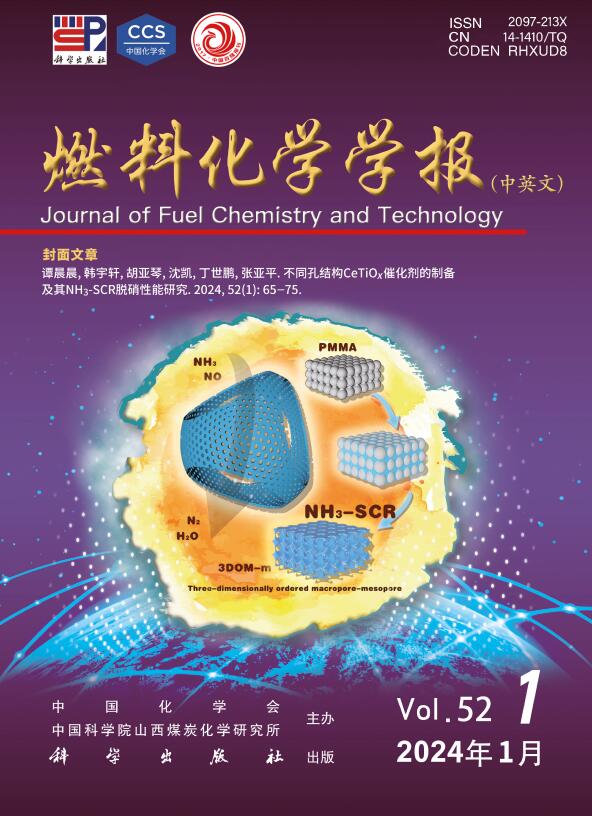Tuning support morphology to control alloy over PtCo/γ-Al2O3 for the preferential oxidation of CO
Q3 Energy
引用次数: 0
Abstract
The preferential oxidation of CO (CO-PROX) reaction is a cost-effective method for eliminating trace amounts of CO from the fuel H2. Pt-based catalysts have been extensively studied for CO-PROX, with their activity influenced by the morphology of the support. Hydrothermal synthesis was employed to produce different morphologies of γ-Al2O3: flower-like γ-Al2O3(f) exposing (110) crystal faces, sheet-like γ-Al2O3(s) revealing (100) crystal faces, and rod-like γ-Al2O3(r) displaying (111) crystal faces, followed by loading PtCo nanoparticles. The exposed crystal faces of the support impact the alloying degree of the PtCo nanoparticles, and an increase in the alloying degree correlates with enhanced catalyst reactivity. Pt3Co intermetallic compounds were identified on γ-Al2O3(f) exposing (110) crystal faces, and PtCo/γ-Al2O3(f) showed high catalytic activity in the CO-PROX reaction, achieving 100% CO conversion across a broad temperature range of 50−225 °C. In contrast, only partial alloying of PtCo was observed on γ-Al2O3(s). Furthermore, no alloying between Pt and Co occurred in PtCo/γ-Al2O3(r), resulting in a reaction rate at 50 °C that was merely 11% of that of PtCo/γ-Al2O3(f). The formation of Pt3Co intermetallic compounds led to a more oxidized state of Pt, which significantly diminished the adsorption of CO on Pt and augmented the active oxygen species, thereby facilitating the selective oxidation of CO.
通过调整载体形貌来控制PtCo/γ-Al2O3对CO的优先氧化
CO- prox优先氧化反应是去除燃料H2中微量CO的一种经济有效的方法。pt基催化剂对CO-PROX的催化活性受到载体形态的影响,因此得到了广泛的研究。采用水热合成法制备了不同形貌的γ-Al2O3:花状γ-Al2O3(f)显示(110)晶面、片状γ-Al2O3(s)显示(100)晶面、棒状γ-Al2O3(r)显示(111)晶面,然后加载PtCo纳米颗粒。载体暴露的晶面影响PtCo纳米颗粒的合金化程度,合金化程度的提高与催化剂反应活性的增强有关。在γ-Al2O3(f)晶面上发现了Pt3Co金属间化合物,PtCo/γ-Al2O3(f)在CO- prox反应中表现出很高的催化活性,在50 ~ 225℃的宽温度范围内实现了100%的CO转化率。相比之下,γ-Al2O3(s)上只观察到PtCo的部分合金化。此外,PtCo/γ-Al2O3(r)中Pt和Co之间没有发生合金化,导致在50°C时的反应速率仅为PtCo/γ-Al2O3(f)的11%。Pt3Co金属间化合物的形成使Pt处于更强的氧化状态,显著降低了CO在Pt上的吸附,增加了活性氧,从而有利于CO的选择性氧化。
本文章由计算机程序翻译,如有差异,请以英文原文为准。
求助全文
约1分钟内获得全文
求助全文
来源期刊

燃料化学学报
Chemical Engineering-Chemical Engineering (all)
CiteScore
2.80
自引率
0.00%
发文量
5825
期刊介绍:
Journal of Fuel Chemistry and Technology (Ranliao Huaxue Xuebao) is a Chinese Academy of Sciences(CAS) journal started in 1956, sponsored by the Chinese Chemical Society and the Institute of Coal Chemistry, Chinese Academy of Sciences(CAS). The journal is published bimonthly by Science Press in China and widely distributed in about 20 countries. Journal of Fuel Chemistry and Technology publishes reports of both basic and applied research in the chemistry and chemical engineering of many energy sources, including that involved in the nature, processing and utilization of coal, petroleum, oil shale, natural gas, biomass and synfuels, as well as related subjects of increasing interest such as C1 chemistry, pollutions control and new catalytic materials. Types of publications include original research articles, short communications, research notes and reviews. Both domestic and international contributors are welcome. Manuscripts written in Chinese or English will be accepted. Additional English titles, abstracts and key words should be included in Chinese manuscripts. All manuscripts are subject to critical review by the editorial committee, which is composed of about 10 foreign and 50 Chinese experts in fuel science. Journal of Fuel Chemistry and Technology has been a source of primary research work in fuel chemistry as a Chinese core scientific periodical.
 求助内容:
求助内容: 应助结果提醒方式:
应助结果提醒方式:


